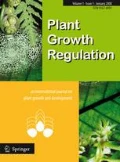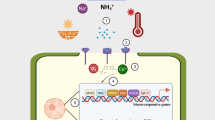Abstract
The small heat shock proteins (sHSPs) are most prevalent in plants and are believed to play an important role in stress tolerance. Our microarray and qRT-PCR analyses of rice plants showed that the gene Oryza sativa Multi-Stress-Responsive 4 (OsMSR-4) is induced by heat, drought, and cold in different tissues at various developmental stages. OsMSR-4 encodes a Class III sHSP. Its expression in Arabidopsis thaliana conferred enhanced tolerance to drought accompanied by altered expression of other stress-related genes. Under drought conditions, levels of free proline were higher in transgenic plants than in the wild-type. The transgenics also showed decreased sensitivity to abscisic acid (ABA) during the seed germination and post-germination stages. Our study provides evidence that OsMSR4 has a key role in regulating plant responses to ABA and drought.




Similar content being viewed by others
Abbreviations
- ABA:
-
Abscisic acid
- ACD:
-
“a-crystallin” domain
- MS:
-
Murashige and Skoog
- NLS:
-
Nuclear localization signal
- ORF:
-
Open reading frame
- OsMSR-4 :
-
Oryza sativa Multi-Stress-Responsive Gene 4
- qRT-PCR:
-
Quantitative real-time PCR
- RT-PCR:
-
Reverse-transcription PCR
- sHSPs:
-
Small heat shock proteins
- WT:
-
Wild type
References
Basha E, O’Neill H, Vierling E (2012) Small heat shock proteins and a-crystallins: dynamic proteins with flexible functions. Trends Biochem Sci 37:106–117
Bates LS, Waldren RP, Teeare ID (1973) Rapid determination of free Pro for water-stress studies. Plant Soil 39:205–207
Chaves MM, Maroco JP, Pereira JS (2003) Understanding plant response to drought-from the genes to the whole plant. Funct Plant Biol 30:239–264
Chen RJ, Dong JL, Liu SB, Xu ZJ, Gao XL (2012) isolation of a novel abscisic acid stress ripening (OsASR) gene from rice and analysis of the response of this gene to abiotic stresses. Afr J Biotechnol 11:13873–13881
Clough SJ, Bent AF (1998) Floraldip: a simplified method for Agrobacterium-mediated transformation of Arabidopsis thaliana. Plant J 16:735–743
Cope LM, Irizarry RA, Jaffee HA, Wu Z, Speed TP (2004) A benchmark for Affymetrix GeneChip expression measures. Bioinformatics 12:323–331
Guan JC, Jinn TL, Yeh CH, Feng SP, Chen YM, Lin CY (2004) Characterization of the genomic structures and selective expression profiles of nine class I small heat shock protein genes clustered on two chromosomes in rice (Oryza sativa L.). Plant Mol Biol 56:795–809
Horwitz J (1992) Alpha-crystallin can function as a molecular chaperone. Proc Natl Acad Sci USA 89:10449–10453
Huo HQ, Dahal P, Kunusoth K, McCallum CM, Bradford KJ (2013) Expression of 9-cis-epoxycarotenoid dioxygenase 4 is essential for thermoinhibition of lettuce seed germination but not for seed development or stress tolerance. Plant Cell 25:884–900
Irrizary RA, Bolstad BM, Collin F, Cope LM, Hobbs B, Speed TP (2003) Summaries of Affymetrix Genechip probe level data. Nucleic Acids Res 15:1–8
Jiang CH, Xu JY, Zhang H, Zhang X, Shi JL, Li M, Ming F (2009) A cytosolic class I small heat shock protein, RcHSP17.8, of Rosa chinensis confers resistance to a variety of stresses to Escherichia coli, yeast and Arabidopsis thaliana. Plant Cell Environ 32:1046–1059
Kishor P, Hong Z, Miao GH, Hu C, Verma D (1995) Overexpression of [delta]-pyrroline-5-carboxylate synthetase increases proline production and confers osmotolerance in transgenic plants. Plant Physiol 108:1387–1394
Lee SC, Hwang BK (2009) Functional roles of the pepper antimicrobial protein gene, CaAMP1, in abscisic acid signaling, and salt and drought tolerance in Arabidopsis. Planta 229:383–391
Li H, Gao Y, Xu H, Dai Y, Deng DQ, Chen JM (2013) ZmWRKY33, a WRKY maize transcription factor conferring enhanced salt stress tolerances in Arabidopsis. Plant Growth Regul 70:207–216
Lindquist S, Craig EA (1988) The heat-shock proteins. Annu Rev Gene 22:631–677
Mahmood T, Safdar W, Abbasi BH, Saqlan Naqvi SM (2010) An overview on the small heat shock proteins. Afr J Biotechnol 9:927–949
Perez DE, Hoyer JS, Johnson AI, Moody ZR, Lopez J, Kaplinsky NJ (2009) BOBBER1 is a noncanonical Arabidopsis small heat shock protein required for both development and thermotolerance. Plant Physiol 151:241–252
Sarkar NK, Kim YK, Grover A (2009) Rice sHsp genes: genomic organization and expression profiling under stress and development. BMC Genom 10:393–398
Shinozaki K, Yamaguchi-Shinozaki K, Seki M (2003) Regulatory network of gene expression in the drought and cold stress responses. Curr Opin Plant Biol 6:410–417
Siddique M, Port M, Tripp J, Weber C, Zielinski D, Calligaris R, Winkelhaus S, Scharf KD (2003) Tomato heat stress protein Hsp16.1-CIII represents a member of a new class of nucleocytoplasmic small heat stress proteins in plants. Cell Stress Chaperones 8:381–394
Swindell WR, Huebner M, Weber AP (2007) Transcriptional profiling of Arabidopsis heat shock proteins and transcription factors reveals extensive overlap between heat and non-heat stress response pathways. BMC Genom 8:125
Trent JD (1996) A review of acquired thermo tolerance, heat-shock proteins, and molecular chaperones in archaea. FEMS Microbiol Rev 18:249–258
Verslues PE, Zhu JK (2007) New developments in abscisic acid perception and metabolism. Curr Opin Plant Biol 10:447–452
Wang WX, Vinocur B, Altman A (2003) Plant responses to drought, salinity and extreme temperatures: towards genetic engineering for stress tolerance. Planta 218:1–14
Wang WX, Vinocur B, Shoseyov O, Altman A (2004) Role of plant heat-shock proteins and molecular chaperones in the abiotic stress response. Trends Plant Sci 9:244–252
Waters ER, Lee GJ, Vierling E (1996) Evolution, structure and function of the small heat shock proteins in plants. J Exp Bot 47:325–338
Xue Y, Peng R, Xiong A, Li X, Zha D, Yao Q (2010) Overexpression of heat shock protein gene hsp26 in Arabidopsis thaliana enhances heat tolerance. Biol Plant 54:105–111
Yamaguchi-Shinozaki K, Shinozaki K (1994) A novel cis-acting element in an Arabidopsis gene is involved in responsiveness to drought, low-temperature, or high-salt stress. Plant Cell 6:251–264
Yamaguchi-Shinozaki K, Shinozaki K (2005) Organization of cis-acting regulatory elements in osmotic- and cold-stress-responsive promoters. Trends Plant Sci 10:88–94
Ye SF, Yu SW, Shu LB, Wu JH, AiZ Wu, Luo LJ (2012) Expression profile analysis of 9 heat shock protein genes throughout the life cycle and under abiotic stress in rice. Chin Sci Bull 57:336–343
Yoshiba Y, Nanjo T, Miura S, Yamaguchi-Shinozaki K, Shinozaki K (1999) Stress-responsive and developmental regulation of ∆1-pyrroline-5-carboxylate synthetase 1 (P5CS1) gene expression in Arabidopsis thaliana. Biochem Biophys Res Comm 261:766–772
Zou J, Liu AL, Chen XB, Zhou XY, Gao GF, Wang WF, Zhang XW (2009) Expression analysis of nine rice heat shock protein genes under abiotic stresses and ABA treatment. J Plant Physiol 166:851–861
Zou J, Liu CF, Liu AL, Zou D, Chen XB (2012) Overexpression of OsHsp17.0 and OsHsp23.7 enhances drought and salt tolerance in rice. J Plant Physiol 169:628–635
Acknowledgments
This research was supported by the Science and Technology Key Project of Hu Nan Province, P. R. China (S2011F2022).
Author information
Authors and Affiliations
Corresponding author
Electronic supplementary material
Below is the link to the electronic supplementary material.
Rights and permissions
About this article
Cite this article
Yin, X., Huang, L., Zhang, X. et al. Expression of rice gene OsMSR4 confers decreased ABA sensitivity and improved drought tolerance in Arabidopsis thaliana . Plant Growth Regul 75, 549–556 (2015). https://doi.org/10.1007/s10725-014-0020-z
Received:
Accepted:
Published:
Issue Date:
DOI: https://doi.org/10.1007/s10725-014-0020-z




